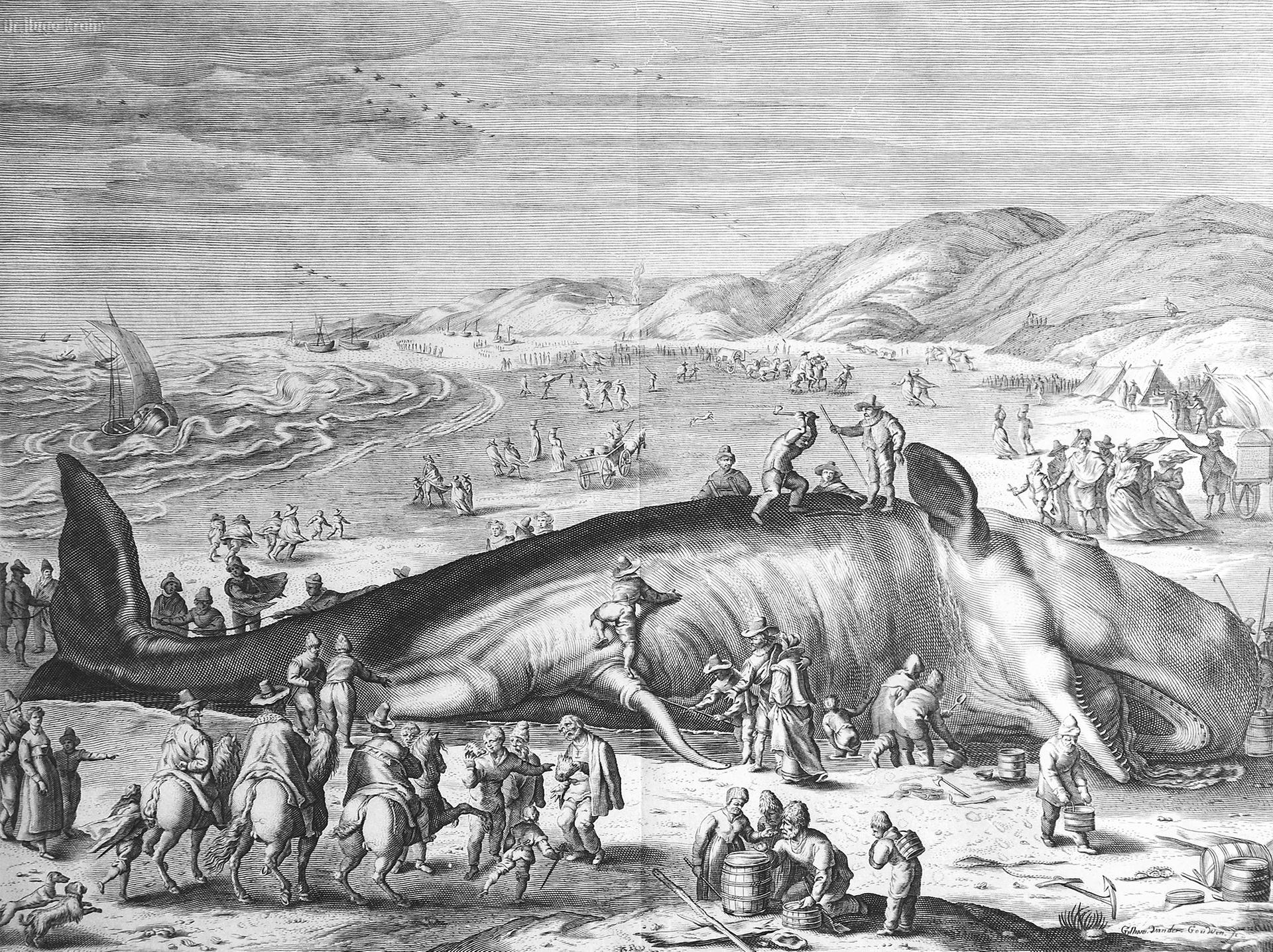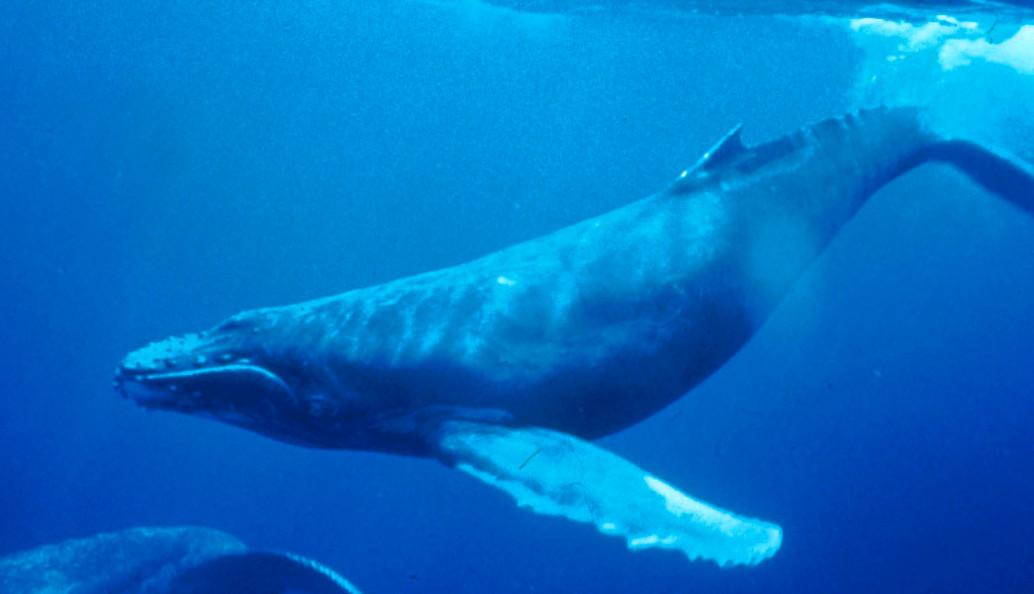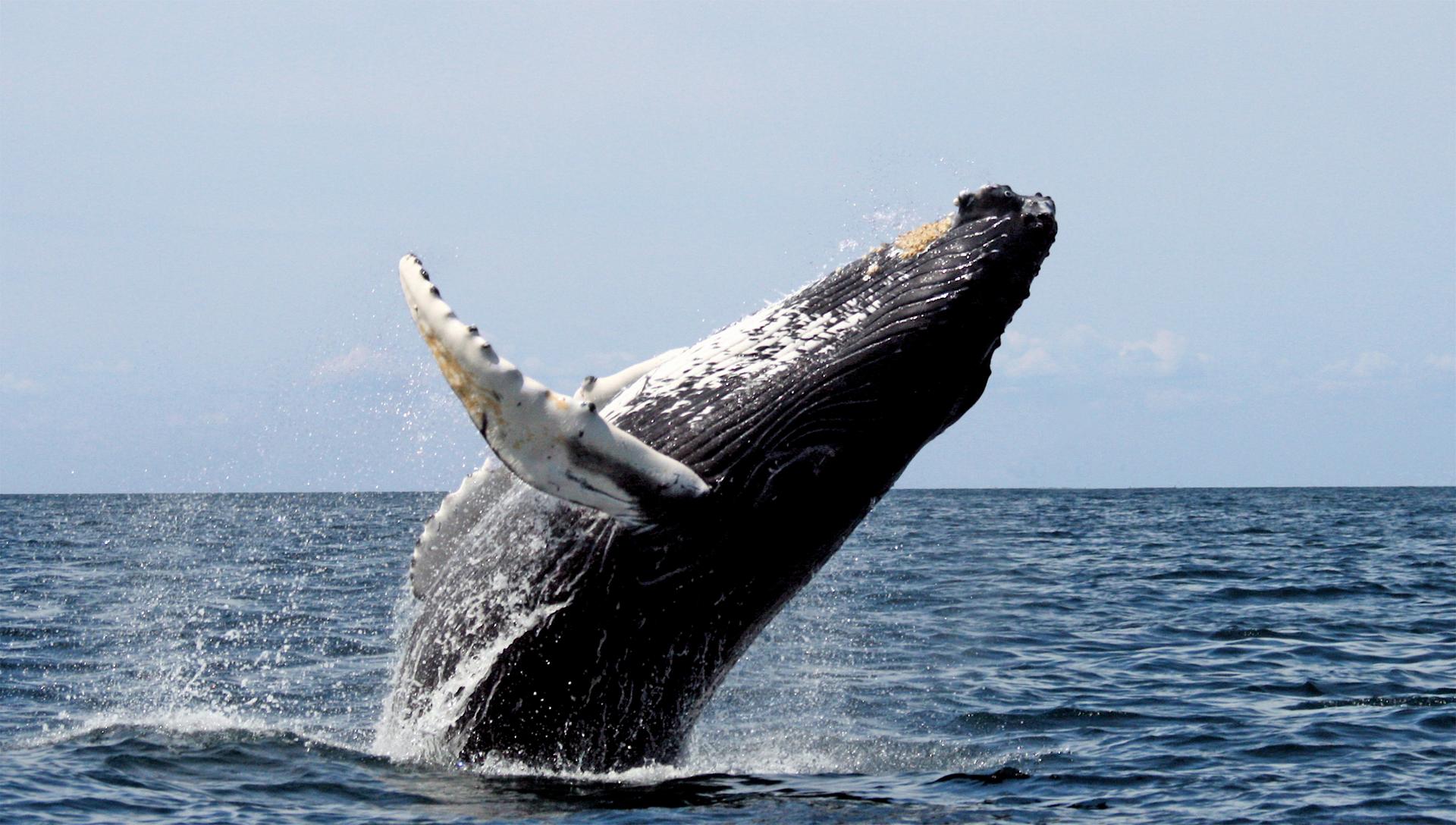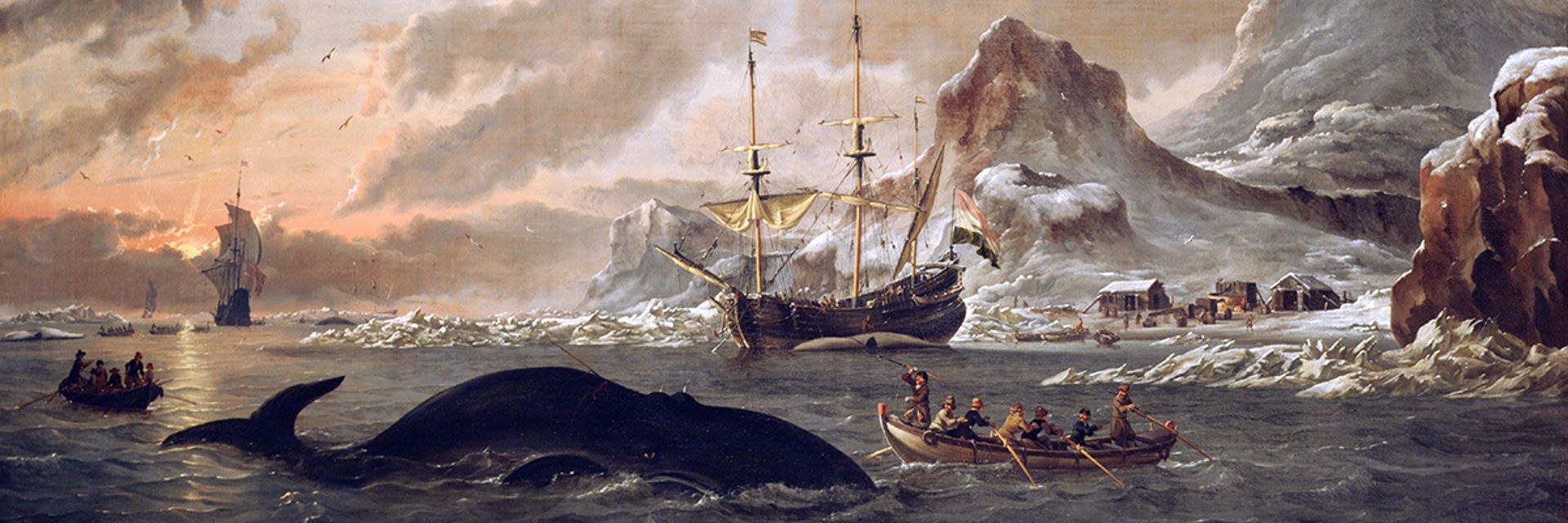Humans have been hunting whales for centuries, and the effects on these magnificent mammals have been devastating. Threatened by the endless needs of human commerce and culture, their predicament is concerning. But perhaps there’s a way to envision a more integrated world, with protected wild spaces along with areas for human development. The prospect of “rewilding” can be a lodestar for a healthier, more sustainable world.
◊
Can “rewilding,” a term popularized by conservation activist George Monbiot, save the whales? These enormous and awe-inspiring creatures dominated our oceans for millennia. Now, with their habitats worldwide being threatened, and their numbers decimated, whales may need the protection of a rewilding program. If maintained long enough, the whales' entire ecosystem could be restored.
Rewilding offers a holistic approach to the restoration and protection of natural environments so that endangered animals can recover and allow nature to restore harmony to wild habitats. MagellanTV’s article “Returning Species and Green Cities'' takes a deeper dive into the prospects of this promising approach.
Watch Titans of the Deep 4k on MagellanTV now!
A Brief History of Whaling
The nearly 100 species of cetaceans (the family that includes whales) were once found in plentiful numbers in every ocean. In fact, it was barely three centuries ago – a blink of an eye in Earth’s epochal timeline – that whales sat atop a global marine ecosystem. That is, until the effects of organized whale hunting began to be felt.
In the 17th and 18th centuries, commercial fishing fleets targeting whales started to make an impact on the health and numbers of the whale population worldwide. The dawning of the Industrial Age saw the need for oil rise dramatically, and whales, due to their reserves of fatty adipose tissue, called blubber, became ever more desirable to hunt. Whale meat has also been a food staple in certain societies, including Japan and other Asian seafaring countries as well as Norway and its neighbors along the Arctic Circle.

Sperm whale ashore in Holland, 1598. Engraving by artist Gilliam van der Gouwen. (Image Credit: Wikimedia)
Over the centuries of hunting by humans, whales disappeared from many habitats, particularly areas close to coastlines. As the readily available numbers diminished, whaling ships expanded their operations into deeper ocean waters.
Whalers of the past found uses for some surprising parts of the whale. Blubber, of course, was used to produce oil-based lubricant. Whale bones were carved into prized scrimshaw designs and corset stays. Even the whale’s excretions, a substance called ambergris, came to be used as an essential aromatic oil in perfumes.
The IWC and Its Struggles to Protect Whales
It was only in the mid-20th century that countries banded together to assess the damage that had been done over preceding centuries. The first major step in protecting whales from the damage of overharvesting took place after the Second World War, in 1946, with the establishment of the International Whaling Commission (IWC). Member nations, including the U.S. and Britain, witnessed the ongoing damage to the international stock of whales and other cetaceans, and were moved to act.
The twin goals of the IWC are to regulate whaling and to manage its ongoing viability. These objectives, to be blunt, are often in conflict, and member nations are sometimes divided over which of the objectives is primary. For example, Japan, a longtime member of the IWC, left the group in 2019 over a dispute in the Southern Ocean. Japan had been killing hundreds of whales there annually for years, despite repeated complaints from the IWC and its other member nations. Japan’s defense was that the country engaged in whaling for scientific purposes, which is allowed under the IWC treaty. However, in fact, Japan’s annual “scientific” catch was regularly diverted for commercial reasons, i.e., consumption.

Protesters in Melbourne, Australia, demonstrate against Japan's whaling practices, 2018. (Image Credit: Wikimedia)
Japan announced it would leave the IWC and cease its whaling activities in the Southern Ocean in accordance with the IWC’s position. However, the nation also vowed to increase its hunting within its own territorial waters. It has also dropped its pretext that it was harvesting whales for scientific purposes and is overtly using its catch for commerce.
In Japan, eating whale meat has declined significantly over the past several decades. From its peak in the 1960s, consumption of whale has diminished to the point that now it is regarded as a specialty item, and the average person in Japan eats only one ounce of it annually.
It’s not only whale hunting that has caused the loss of whale populations and the despoilment of their habitats. Other hazards of maritime life include the devastation of whales caught in fishing nets, deadly collisions with sea vessels, and anthropogenic – human-made – noise pollution that confounds whale communication and navigation.
All these factors lead marine biologists to be concerned about not only the wellbeing of whales, but also the health of their habitats. Protected areas in the seas are few in number, and so awareness is growing for the need to demarcate more areas of oceans as conservation sites. This will protect the current population of whales and promote their greater health and well-being.
The Oceans’ “Circle of Life”
When whales thrive, they are part of the grand “circle of life” of the briny deep, affecting myriad species. Baleen whales, those cetaceans that use a filter system to feed, encompass many species. These include the humpback whale, the blue whale, and the gray whale. Unlike some of their relatives, such as orcas, these enormous carnivores have no teeth. To feed, they inhale seawater. As they release the water, tiny crustaceans called krill become caught up in the baleen, or whalebone, and are consumed by the whales.
Baleen whales are active at virtually all depths of the ocean, spending much of their time feeding close to the seafloor. Upon rising from the deep, they release voluminous sprays of whale feces that settle just below the surface. This excrement is then exposed to sunlight, where the process of photosynthesis attracts phytoplankton to consume it – along with significant amounts of heat-creating carbon.
Phytoplankton have a negative carbon footprint. This means they consume, rather than create, carbon as part of their natural processes, making them key to the health of life on the planet. Not only do these microscopic creatures counter global warming, they also serve as food stock for larger microbes called zooplankton.

Humpback whales spend 90% of their lives underwater. Their main threats from humans besides whaling are being trapped in fishing gear, collisions with ships, and noise pollution. (Image Credit: Wikimedia)
Zooplankton, in turn, serves to feed krill, which in turn feeds the whale, thus completing the circle. The larger areas where whales are protected are beneficial to the Earth as well as sea life, which tends to thrive where there are large pods of whales. And the whales are able to maintain their migratory pathways, communicate and socialize with other cetaceans, and hunt for sustenance without man-made obstructions.
At peak population, centuries ago, whales sequestered tens of millions of tons of carbon per year.
As whale stocks regenerate, other marine wildlife bounce back quickly. Fish, crustaceans, and other mammals such as dolphins increase in volume and size, which safeguards healthy seas and sequesters more carbon. In addition, whales push plankton to the surface as they rise, placing the tiny sea creatures where they can more effectively survive and reproduce.
Whales are a keystone species. When such species are endangered, the ecosystems in which they live become less habitable not only for them but for many other species. To restore such damaged systems, one promising approach, promoted by British writer George Monbiot, is called rewilding.
What Is Rewilding, and Who Is George Monbiot?
In 2013, George Monbiot published Feral, a book that laid out an innovative vision for the restoration and recovery of endangered flora and fauna. In Feral, Monbiot promotes a holistic view of conservation. He suggests that ecologists’ focus on saving species be enlarged for the purpose of allowing wild creatures full range in unspoiled habitat, that is, to rewild those areas.
Rewilding natural spaces (including oceans) by eliminating traces of human activity is a big project, and Monbiot suggests it’s a worthy, if lofty, goal. Broader than species-level restoration, the idea is an attempt to spark the dynamism of selected ecosystems, promoting a healthy life for all wild nature in them. In these formerly domesticated spaces, the reintroduction of endangered or threatened species offers hope for the ultimate goal of a healthier planet for animals as well as humans.
George Monbiot uses his book Feral to promote an idea of “rewilding ourselves.” In the return of wonder and hope to people, he says, rewilding pays a dividend to humans.
In the context of rewilding, actions both big and small help. The areas selected for rewilding can be as big as a protected nature reserve, or as small as an expansive back yard. Removing the human imprint is essential; then nature will return quickly. In terms of whales, ceasing fishing and hunting in the area is the essential first step. Additional actions could be to reroute shipping lanes to avoid the rewilded area, and to declare the area off-limits to government, commercial, and military activity.

Humpback whale breaching, a welcome sight for whale-watchers. (Image Credit: Wikimedia)
The benefits of the restoration of natural habitats are many, and mitigating the effects of climate change is prime among them. As we’ve seen with whales, restoring their numbers and habitats protects the “web of life” and benefits humans as well. Restoration of biodiversity lowers greenhouse gas emissions, captures more carbon, and even reduces methane in the environment.
The Limits of Rewilding and the Fate of Whales
As Monbiot himself admits, large-scale rewilding remains contentious, and exists mostly as a theory, not a practice. But, as he says, even little steps in the right direction can help. The IWC has so far named two areas as whale sanctuaries. The Indian Ocean Whale Sanctuary, approximately 70 million square kilometers, was established in 1979, and the Southern Ocean Whale Sanctuary (surrounding Antarctica), an area of 50 million square kilometers, in 1994. And now that Japan has dropped its bad-faith defense of Southern Ocean “scientific” whaling, restoration of that area will certainly accelerate.
These sanctuaries are by no means the only areas where whales and other sea life are protected. The international organization Whale Heritage Sites also certifies much smaller ocean areas near inhabited coastline as ecologically responsible, sustainable locations for ethical whale-watching. So far there are four sites that have been qualified: Hervey Bay, Australia; The Bluff, South Africa; Tenerife-La Gomera Marine Area, Spain; and Dana Point, California. There are about half a dozen sites currently being considered for future certifications.
What’s the Future for Whales?
Few nations still hunt whales, but the damage caused by several centuries of largely unfettered whaling has decimated the species. For our generation, conservation is a must. Little by little, there’s a lot to be done.
For example, adding new seas to the IWC sanctuary list has been stymied for decades. Repeated efforts to add significant areas of the South Pacific and South Atlantic oceans have been unsuccessful. Nonetheless, conservation activity has spawned some notable successes.
In the early years of the 20th century, humpback whales were hunted in the South Atlantic almost to extinction. There were as few as 450 of these whales left, but now, thanks to assiduous efforts to revive the species and its habitat, their number has increased to approximately 25,000. Gray whales, too, are making a comeback since gaining protection by the IWC in 1949, and there are even suggestions afloat to repopulate Britain’s coastal waters by “airlifting” grays from the Pacific Ocean to improve marine ecosystems and boost ecotourism.
Around our planet, most desirable spaces have already been claimed by human society, especially since the human population began to increase rapidly in the mid-19th century. In these densely populated areas, rewilding may be more of an aspiration than an actionable strategy. Perhaps we must first find a place for rewilding in our hearts. If so, then we might one day find the will to live in harmony with the creatures of the sea, land, and sky.
Ω
Kevin Martin is Senior Writer for MagellanTV. He writes on a wide variety of topics, including outer space, the fine arts, and modern history. He has had a long career as a journalist and communications specialist with both nonprofit and for-profit organizations. He resides in Glendale, California.
Title Image: Dutch whalers near Spitsbergen, Abraham Storck, 1690
Collection of the Rijksmuseum, Amsterdam

